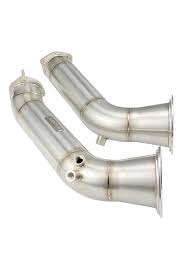There’s something quietly captivating about performance cars that goes beyond the usual chatter about horsepower or top speed. It’s not always the flashy numbers or the attention-grabbing aesthetics that thrill you. Sometimes, it’s the subtleties — the little moments where a car feels more alive, more connected to your own rhythm. That’s the magic of thoughtful tuning, the kind that respects a vehicle’s character while enhancing it in ways you can feel rather than just measure.
Take the C63 W205, for example. Even stock, it’s a machine that exudes confidence. That burbling exhaust, the turbocharged growl, the way the engine responds with a purposeful surge — it’s unmistakably Mercedes-AMG. Yet, owners often whisper about a subtle frustration: the car has all the right instincts, but sometimes it feels slightly restrained, as if it’s holding back just enough to make you notice. That’s where something like mercedes c63 w205 catted and catless downpipes enters the conversation. These upgrades aren’t about radical change or obnoxious volume. They’re about clarity. The engine exhales better, the turbos respond a little faster, and the car’s exhaust note gains a deeper, more purposeful tone. Suddenly, the C63 feels closer to the car you imagined when you first saw it in the showroom, that perfect combination of aggression and elegance.
What I find fascinating is how subtle the effect can be. You’re not slapping on a set of aftermarket intakes or a wildly loud exhaust. You’re simply improving the car’s natural workflow. And yet, once installed, you start noticing the difference everywhere. Morning commutes feel more intentional. Twisty back roads feel more alive. Even sitting at a light, there’s a quiet confidence in the way the engine hums. It’s like listening to a musician you’ve loved for years finally playing the song exactly how it was meant to sound.
Shift your attention from the sedan world to the hatchback domain, and the conversation takes on a slightly different flavor. The Mercedes A45S is a car that wears its personality on its sleeve. Compact yet explosive, refined yet feral — it’s a car designed to make its presence felt. But as with many factory setups, even a stellar engine can benefit from a little breathing room. Enter the mercedes a45s decat downpipe . The term might sound intimidating, but the effect is surprisingly elegant. By improving exhaust flow and reducing restrictions, the A45S gains a sharper throttle response and a more expressive, snarling exhaust note. It’s a small tweak, but one that makes the car feel far closer to the performance legend AMG intended it to be.
And what’s delightful is that the impact isn’t just technical; it’s emotional. Drivers describe an extra spring in the car’s step, a sense of immediacy behind the wheel, and a visceral thrill that reminds them why they fell in love with the model in the first place. It’s the difference between a finely written story that’s just good on paper and one that resonates with you long after you’ve finished reading. That’s the subtlety of a well-executed downpipe upgrade — it transforms without shouting.
Of course, the world of performance modifications can be a maze. There are materials to consider — stainless steel, titanium, or ceramic coatings — as well as fitment concerns, tuning requirements, and the ever-present whispers of forum debates. It’s easy to get lost in the noise, comparing brands or debating ideal setups. But the heart of the matter is simple: choose what enhances your driving experience without compromising reliability. Think of it as a gentle nudge rather than a radical overhaul.
There’s also the beauty in the difference between vehicles like the C63 and A45S. One is a commanding sedan, almost regal in its aggression; the other is a compact powerhouse, brimming with mischief and attitude. Yet both benefit from the same underlying philosophy: let the engine breathe, let the exhaust sing, and let the car’s character shine through. It’s about tuning for feeling, not just numbers. You might not notice a dramatic increase on the dyno, but you’ll notice it every time you accelerate, downshift, or just enjoy the quiet rumble at idle.
Another understated pleasure is how these upgrades reshape the entire driving experience. With downpipes in place, acceleration feels more confident, revs are smoother, and the car communicates its intentions with greater precision. Ordinary roads suddenly invite engagement. City streets become playgrounds of subtle feedback. And the best part? You hardly have to explain it to anyone else. It’s your private, tangible reward — the kind of satisfaction that comes from investing in something you love, simply because it feels right.
It’s also worth noting that subtlety can be more satisfying than flashiness. A car with an upgraded downpipe doesn’t scream for attention in the wrong moments, yet when you want it to perform, it delivers with unmistakable authority. The C63 doesn’t just accelerate; it asserts. The A45S doesn’t just corner; it challenges. These upgrades preserve the cars’ original personalities while allowing them to speak more confidently, more vividly.
By the time you’ve driven these cars post-upgrade, you start to understand the intangible magic of performance tuning. It’s not about breaking records or dominating streets. It’s about connection — feeling the car respond in ways you intuitively recognize, moments that make the drive memorable for reasons you can’t quite quantify. And that’s the subtle genius behind downpipes: they let you experience what was always there, more clearly, more profoundly.
At the end of the day, whether it’s a C63 sedan asserting its presence on the freeway or an A45S hatchback carving corners with mischief, downpipes remind us why we love driving. They’re a gentle enhancement, a way to align mechanical precision with human intuition, a bridge between machine capability and emotional response. And when you sit behind the wheel, feel the throttle respond, and hear the exhaust note perfectly tuned to the car’s soul, you remember why it’s all worth it.

